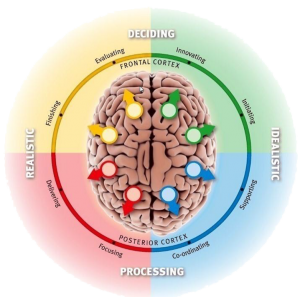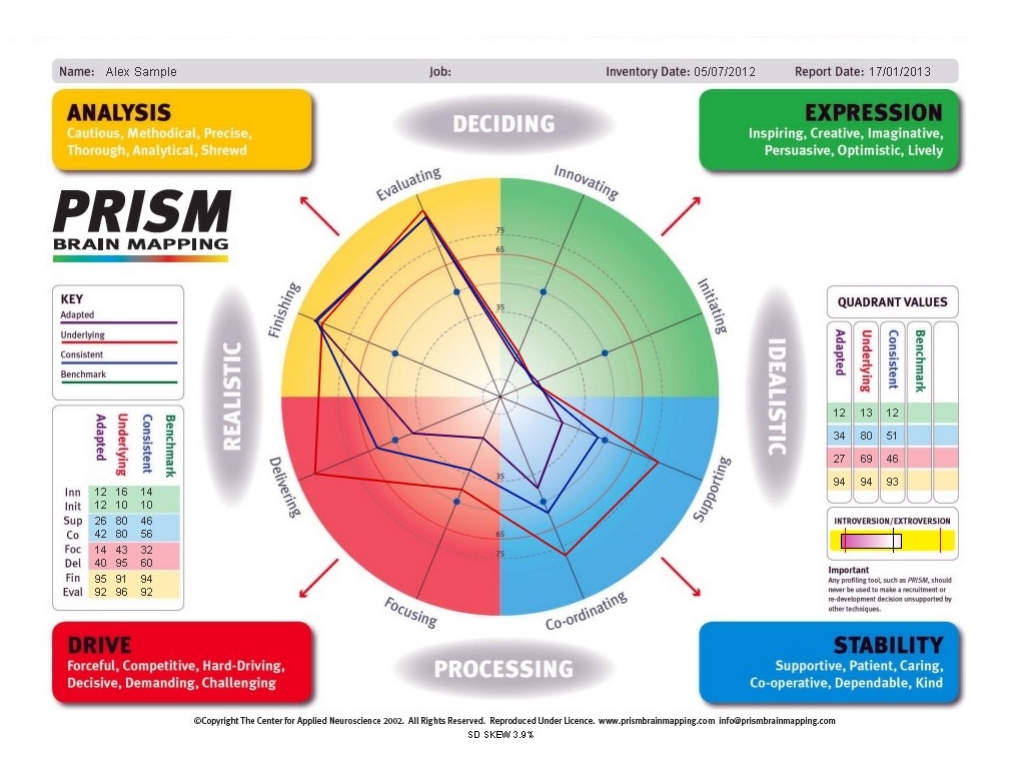PRISM: Your Behavioural Strengths.
Categories: Behavioural and Strengths Diagnostic Tools, Coaching & Leadership, Personal Development and Self Understanding
The purpose of this post is to provide a brief introduction to how PRISM Brain Mapping can be used in the coaching context.
There are many diagnostic tools that people can use to help better understand their strengths and areas for development, their behavioural preferences, their impact on others and their personality types. Some of these, such as the Myers-Briggs Type Indicator (MBTI) and the Hermann Brain Dominance Instrument (HBDI) have been used for many years and are well known. Others such as PRISM Brain Mapping and Human Synergistics’ Life Styles Indicator (LSI) and other Human Synergistics’ tools are less well known but also widely used in organisations around the world.
In the coaching context these diagnostic tools provide a valuable way for people to gain a better understanding of their strengths, what drives them and how the way they behave impacts on others. To some degree these diagnostic tools provide different information and insights. I find several helpful to clients in the coaching space. The most powerful and comprehensive diagnostic tool, in my experience, is PRISM Brain Mapping which has started being used in Australia over the past year.
“PRISM is different because it is a neuroscience-based instrument specifically designed to identify the behavioural preferences that directly relate to personal relationships and work performance. Rather than the theoretical concepts of many other tests, PRISM measures the things that people like doing and the behavioural characteristics related to those things.” (Source: The Centre for Applied Neuroscience).
As I have noted above, PRISM is different from other diagnostic tools in that it provides the most comprehensive suite of reporting I have found. For any individual it can include: a map of behavioural preferences; a work preference profile; a career development analysis; an emotional intelligence report; a ‘Big Five’ report against the traits of extraversion, agreeableness, conscientiousness, emotional stability and openness to experience; and a mental toughness analysis. The analysis and reporting is based around 8 behavioural dimensions, as indicated in the following picture.
PRISM also has an advantage over many other tools in that it can be run in either self-assessment mode or 360 feedback mode.
PRISM is often used in recruitment processes as an aid to determining suitability of individuals for particular roles. For me its real power is in the coaching space. I find many clients value it as a way of better understanding: their behavioural strengths; the potential impact of their behaviours on others in the workplace; where their behavioural preferences might leave them vulnerable; how they might need to adapt to different roles; and more. I have also found PRISM valuable in informing team dynamics, creating a greater awareness among team members of the different behavioural preferences of individual team members and how they might work more effectively together.
One of the most powerful elements of PRISM is the Brain Mapping against the eight behavioural dimensions of: innovating; initiating; supporting; co-ordinating; focussing; delivering; finishing; and evaluating. As shown in the example map below, PRISM maps an individual’s preferred behaviour against each dimension (the red line); the behaviour the individual feels they need to adopt in their current role (the purple line); and what it is others are most likely to be observing (the blue line).
This mapping provides an extraordinarily powerful tool for self-understanding. For example, by reference to the map above:
- what are the implications of having a strong behavioural preference for Delivering (as shown by the red line above)?
- what does it mean for the individual that the adapted behaviour (the purple line) for Delivering is so much less than the preferred behaviour?
- what does it mean that for some behavioural dimensions the three coloured lines are so closely in alignment?
- are there risks associated with the strong preferences for Finishing and Evaluating?
- what might the strong preferences for Finishing and Evaluating mean for team dynamics given there is such a strong correlation between the preferred and adapted behavioural styles?
- do the low behavioural preferences against Innovating and Initiating indicate areas of weakness that need to be addressed?
- what might be the implications of very high preferences in Finishing and Evaluating coupled with the client’s strong tendency to introversion (as indicated by the scale at the bottom right of the above map)?
These questions provide just a peek through the window of some of the insights and conversation that starts to open up when using PRISM.
To get a better appreciation of how PRISM might be of value, you can review the PRISM website. Please also feel free to contact us to discuss its application to your individual needs or how it might be valuable in identifying ways your team can work more effectively together.
Images: The above images are the copyright property of the Center of Applied Neuroscience and have been reproduced here with their permission.
(If you would like to receive notification of future blog posts please send an email, at the link on the contact page, with the word ‘Subscribe’ in the message field.)


